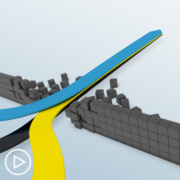Overcoming Barriers in Myelofibrosis Care: Challenges Faced by Patients and Providers
Overcoming Barriers in Myelofibrosis Care: Challenges Faced by Patients and Providers from Patient Empowerment Network on Vimeo.
What are key myelofibrosis barriers and solutions for healthcare providers? Experts Dr. Raajit Rampal from Memorial Sloan Kettering Cancer Center and Dr. Jeanne Palmer from Mayo Clinic discuss common obstacles to myelofibrosis care and methods they’ve used to overcome barriers including collaborative care tips.
Related Resources:

Expert Insights on Overcoming Barriers to Myelofibrosis Care |

HCP Roundtable: Breaking Through Myelofibrosis Practice Barriers |

Explaining Myeloproliferative Neoplasm Disease Progression to Patients |
Transcript:
Dr. Nicole Rochester:
Dr. Palmer, can you speak to some of the obstacles or barriers faced by healthcare providers themselves when treating myelofibrosis patients?
Dr. Jeanne M. Palmer:
I think one of the challenging pieces, you know, I know in Arizona, we have a pretty big catchment area, because there’s not only the Phoenix metropolitan area, but there are a lot of smaller communities scattered throughout Arizona. And I think one of the issues that we have is, let’s say I want to start somebody on a new medication that potentially has a side effect of anemia or something. Being able to manage them remotely is difficult, because a lot of times they may require a blood transfusion. Can they even get a blood transfusion where they’re at? Can they afford the 5-hour drive down to Phoenix to get that? So I think sometimes, even access to simple things, well, I guess it’s not that simple, but things like blood transfusions can be hard. Fortunately for labs, you’re often able to get them most places through various Labcorp, Quest, et cetera. But sometimes any type of infusional treatment can be really, really hard to get.
Dr. Nicole Rochester:
Thank you. Do you have anything to add, Dr. Rampal, with regard to barriers faced by providers?
Dr. Raajit K. Rampal:
No, I actually think that’s an important, that’s a really important thing. Because it depends on your area of the country and what access to resources patients have locally. If we’re thinking about this as sort of a hub and spoke model, that may be the outdated model. In other words, it’s not that people can afford to, you know, from a financial perspective or a time perspective, come into the major center and then go back. They need to get access to care locally, but you have to have the infrastructure, the healthcare infrastructure, if you will, to deliver that care. And that’s a difficult problem in many parts of the country.
Dr. Nicole Rochester:
Dr. Rampal, can you speak to unforeseen or maybe outdated practice-related barriers that may hinder your work and that of your colleagues with regard to myelofibrosis treatment?
Dr. Raajit K. Rampal:
Yeah, I guess my broad answer to this is that things are changing rapidly and the pace of change is accelerated. In other words, when we think about myelofibrosis, the treatment paradigm probably, if you think about the last 15 years, in the early part of that, things were kind of relatively static and now they’re not as new knowledge emerges, as new treatments emerge. And the challenge here, again, speaking in general terms is, as Dr. Palmer pointed out, this is a rare disease. It’s not something that’s frequently seen by physicians in the community. So how do you keep people up to date on something that is not the majority of what they do? It’s a very small percentage of what they see and do. And that’s an ongoing challenge. And I’m not sure there’s any perfect solution to that except for education. It’s just a question of how do you deliver that in a time-effective manner so that people can devote some time to getting up to date? But it is ultimately a good problem that things are changing rapidly.
Dr. Nicole Rochester:
Absolutely. And, Dr. Palmer, do you have any solutions or actions or things that healthcare providers can do as this treatment landscape rapidly evolves?
Dr. Jeanne M. Palmer:
I think it’s a real challenge because even when we look at sort of the dogma of like, well, what’s the response criteria? I mean, when you’re thinking of a lot of like solid tumors, you think, okay, did the tumor shrink a certain amount? Did the tumor go away? With myelofibrosis, when we think about even response criteria, it’s really challenging. So I think I agree education is part of it, and it’s trying to figure out how to distill down the really important components of how do you manage these patients day-to-day? We can talk about the COMFORT study and the MOMENTUM study and everything else all we want to, that tested, were major studies that tested the drugs that we use, but then the nuances of how to manage them day-to-day is something that I think we could probably improve upon how we educate.



